I’ve been drying food at home for a few years now, and I can tell you this: a dependable food dehydrator has changed the way I snack, preserve food, and even plan meals. From crunchy apple chips to chewy homemade jerky, the results are healthier, cheaper, and often tastier than what I used to grab at the store.
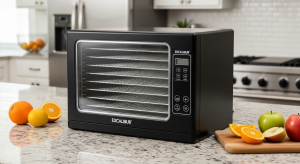
Of course, getting the right unit isn’t always easy. I’ve bought more than one food dehydrator over the years—some fantastic, others not so much. (One gave off a burnt-plastic smell that never quite went away. Lesson learned.)
In this guide, I’ll walk you through what matters most when choosing one food dehydrator, which models I trust, and some of the tricks I’ve picked up along the way.
Here’s what you’ll learn in this guide:
- A quick comparison of the models I recommend.
- Factors I always consider before buying.
- My top choices for different needs like jerky, herbs, or big harvests.
- Simple tips for getting better results and keeping your unit clean.
- Answers to the questions people ask me the most.
Let’s dive in.
Quick Comparison of My Favorite Food Dehydrator
If you just want a snapshot of the best options, here’s a simple chart.
| Model | Capacity | Best For | My Take |
| Excalibur 3926TB | 9 trays | Frequent use | Big, steady, and reliable. My go-to for serious drying. |
| Nesco Snackmaster Pro | Expandable up to 12 trays | Beginners | Affordable, simple, and grows with you. |
| Cosori Premium | 6 trays | Everyday kitchen | Digital controls, stainless steel, and modern design. |
| Magic Mill Commercial | 10 trays | Jerky & large batches | Powerful airflow and dependable heat. |
| Presto Dehydro | 4 trays | Herbs & small spaces | Lightweight, compact, and budget-friendly. |
What I Look For in a Drying Machine
I’ve tested a few models, and over time I’ve noticed that the same features keep making the difference.
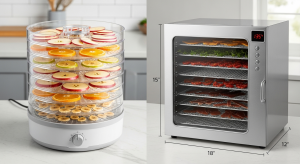
Size and Capacity
If you grow your own produce or like to prep snacks in bulk, more trays will save you time. A smaller unit is fine for light use, but you’ll quickly get tired of running multiple batches. I learned this the hard way with a basket of apples and a four-tray setup. Six runs later, I wished I’d invested in something bigger.
Airflow and Heat Distribution
Uneven drying means half your banana slices end up crunchy while the rest stay sticky. Horizontal airflow tends to be more consistent than vertical, though some stackable models do a decent job if you rotate trays. Personally, I like machines that let me set it and forget it.
Temperature Range and Timer
Different foods need different settings. Jerky requires higher heat, while herbs stay delicate at lower temperatures. A reliable dial or digital control makes this easier. And yes, timers are lifesavers—you don’t want to wake up at 3 a.m. to check on apple chips.
Ease of Cleaning
Fruit leather trays get messy. Sticky residue from bananas or tomatoes can cling forever. That’s why I value removable trays and dishwasher-safe parts. I once spent nearly an hour scrubbing trays by hand. Never again.
Noise Level
Some units hum like a small fan, which is fine. Others roar loud enough to interrupt a TV show in the next room. I stick to quieter models—after all, they sometimes run for 12 hours straight.
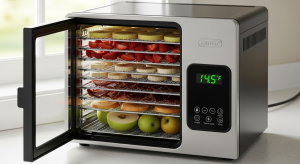
My Top Picks for Different Needs
Here’s where I break it down by use. Because no one machine is perfect for everyone.
Best Overall: Excalibur 3926TB
This one’s my workhorse. With nine trays, it handles large harvests and keeps drying consistent across every level. It’s bulky and takes counter space, but if you dry food regularly, it’s worth the commitment.
Best Budget-Friendly: Nesco Snackmaster Pro
This was my first unit, and I still recommend it to beginners. It’s expandable, so you can start small and add trays later. It doesn’t look fancy, but it’s dependable and affordable.
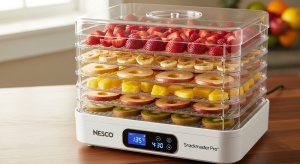
Best for Jerky: Magic Mill Commercial
Strong airflow, dependable heat, and plenty of space make this perfect for meat. My jerky turns out chewy without being brittle. It also feels sturdy enough to handle heavy strips without the trays bending.
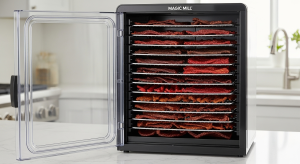
Best for Herbs and Small Jobs: Presto Dehydro
Lightweight and compact, this one is my choice for drying herbs or small fruit batches. It doesn’t dominate counter space and tucks away easily when not in use.
Best Stylish Option: Cosori Premium
Digital display, stainless steel body, and consistent results. This is the unit I’d recommend if you want something that looks sleek and modern while working just as well.
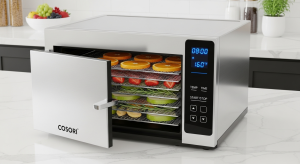
Brand Insights
Certain names keep popping up in my kitchen and in online reviews. Here’s how I see them:
- Excalibur – The heavyweight, known for large, reliable models.
- Nesco – Affordable and practical. Great entry point for beginners.
- Cosori – Stylish, modern, and a good fit for everyday use.
- Magic Mill – Powerful, durable, and popular with jerky makers.
- Presto – Budget-friendly and compact. A good option for light drying.
Tips for Using Your Machine
Owning one is one thing. Getting the most out of it is another.
- Slice Evenly: Uniform slices dry more consistently. A mandoline slicer helps.
- Don’t Overlap: Food needs airflow. Overlapping slows things down.
- Rotate if Needed: Some stackable units do better if you shuffle trays halfway through.
- Check Early: Drying times in manuals are only guidelines. Peek earlier to avoid over-drying.
- Cool Before Storing: Warm food in airtight containers can trap moisture. Let everything cool first.
Cleaning and Maintenance
A little effort after each use goes a long way:
- Soak trays as soon as you’re done.
- Use a soft brush for sticky spots.
- Wipe the interior with a damp cloth.
- Avoid harsh scrubbing that damages trays.
This not only extends the life of the unit but also prevents strong odors from lingering. (Yes, onions. Never again.)
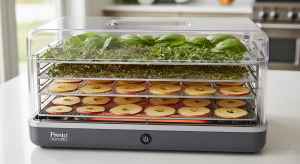
Beyond the Basics: Fun Foods to Try
Most people start with apples or jerky. I did too. But these machines can do more:
- Watermelon strips: They taste like candy.
- Tomato chips: Crunchy, savory, and great for soup toppings.
- Zucchini slices: Add seasoning and they rival potato chips.
- Banana bread leather: Spread batter thin, dry, and cut into strips.
Not every experiment is a success. For example, drying pizza seemed like a good idea once. Let’s just say it wasn’t.
FAQs I Hear a Lot
Can an oven do the same job?
Yes, but not as efficiently. Ovens often don’t go low enough for herbs, and they use more power.
How much does it cost to run one?
Comparable to running a small fan or light. Usually cheaper than buying dried fruit or jerky from the store.
What foods can I dry?
Fruits, vegetables, herbs, jerky, and even sauces turned into leathers. I skip cheese—it doesn’t dry well.
Are they worth the money?
If you garden, hunt, or snack often, yes. Mine paid for itself quickly compared to buying packaged dried snacks.
How long does dried food last?
Stored in airtight containers and kept cool, months to even a year. Vacuum sealing extends it further.
My Final Thoughts
The right machine depends on your needs. Buying a drying machine comes down to how much you’ll actually use it.
If you’re interested in other kitchen tools that make prep easier, check out my guide on the best kitchen knife set 2025. Having sharp knives saves a ton of time when slicing produce or prepping meat for jerky.
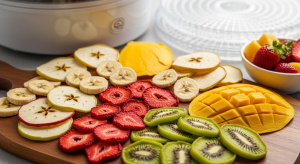
Personally, I use my machines all year long—garden produce in summer, apples in fall, jerky projects in winter. They’ve become reliable partners in my kitchen, and I’d honestly miss them if they were gone.
And yes, I still experiment. Sometimes it works (watermelon strips are amazing). Sometimes it doesn’t (pizza, never again). But that’s part of the fun.